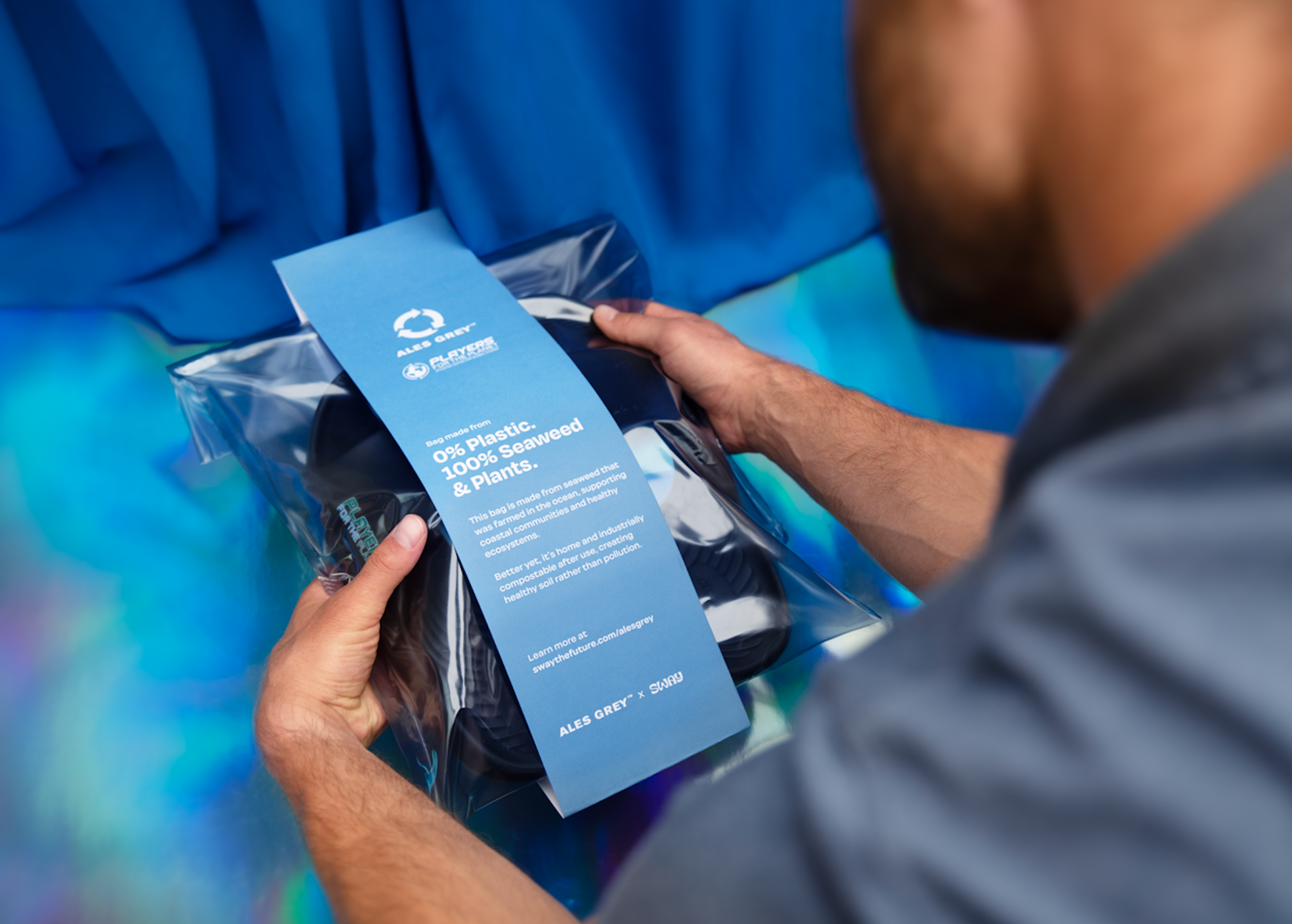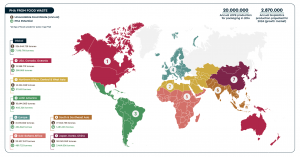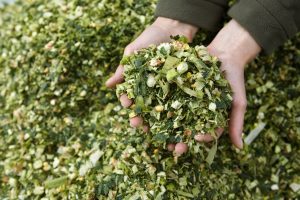
Imagine a future where materials are made from renewable ingredients harvested from our local surroundings: potato skins, fruit peels, and coffee grounds from homes and businesses, woody branches and leaves pruned in city parks, mussel shells and fish scales collected from seafood processors, and regeneratively farmed seaweed bailed up from offshore aquatic farms. These diverse resources are broken down to a common set of material building blocks – cellulose, chitin, starch, glucose – and used as fossil-fuel alternatives to make packaging, textiles, and other products.
Today, petrochemical plastics are one of the largest sources of waste globally, posing significant threats to both the environment and human health. Company-wide environmental, social and governance (ESG) targets along with strict bans on single-use packaging are driving increased innovation in biobased alternatives – materials made from renewable sources of biological origin. With new measures like the Global Plastics Treaty fast developing, The White House pledge to cut fossil-fuel based plastic consumption by 90%, and consumer demand for sustainable products on the rise, biobased materials innovation is at its highest point in almost two decades.
This push for more sustainable materials has led to increased investment in the sector. Biobased alternatives to petroleum, concrete and steel have been backed by a wave of big-name brands like Adidas, Hermès and Unilever. And investors are sending clear signals to companies that they’ll face increasing pressure if they don’t act soon to drastically reduce their plastic footprints.
As renewable alternatives to plastics gain traction, biomass will need to be found in a diversity of places. There are natural limits to sourcing primary biomass based on the world’s available land and the need to grow crops for food and fodder. As governments tighten restrictions on the use of edible feedstocks for bioenergy and biobased materials, and circular and regenerative business models become more commonplace, a diversity of non-competitive and otherwise under-utilised feedstocks are in the innovation spotlight.
Seaweed is one of nature’s most renewable resources since it grows rapidly and doesn’t require land, water or fertiliser. Some species can store up to 20 times more CO₂ than land-based crops, and residues shed onto the ocean floor can create long-term carbon sequestration benefits.
Materials innovators like Sway (USA) and Notpla (UK), winners of the Tom Ford Plastic Innovation Prize and Earthshot Prize respectively, are harnessing the power of seaweed to develop compostable replacements for petrochemical plastic packaging. Seaweed-based materials can replicate many of the properties currently found in petroleum-based plastic applications:

In 2021, seaweed investment deals doubled and more start-ups entered the field in the past two years than ever before. Despite this, areas of the value chain such as processing and distribution are still lacking innovators and entrepreneurs.
Given this rapid growth, seaweed-based innovators themselves are grappling with the challenge of scaling the industry sustainably, with much work and discovery to be done. Organisations like the Great Seaweed Coalition and Seaweed Commons provide nuanced and accessible information on the politics, ecology, governance, and economy of marine algae, promoting an open and informed public discourse for responsible decision-making.
Mycelium – the vegetative filament root structure of mushrooms – can be used to grow materials. Growing mycelium requires little energy, water or food. And if the production of these biodegradable materials involves upcycling of organic waste streams, they can have a lower carbon footprint than fossil-based materials, and in some cases even act as a net CO₂ sink. It’s therefore no surprise that estimates suggest that the global market for mycelium-based products could reach $32 billion by 2025.
Biohm (UK) uses commercial and agricultural waste that would otherwise go to landfill to feed mycelium, creating various products that can be used within the built environment like insulation panels. Because these panels are 100% natural, they can be remanufactured, broken down into feedstock, or used as compost.
Growth chambers that guide mycelium fibres into large sheets are also used by companies such as Ecovative (USA). The vertical farms grow pure mycelium products like hides and foams at industrial scales, helping them to meet the growing needs of the biobased material industry.

Unavoidable food waste (UFW) is waste arising from food or drink preparation that is not, and has not been, edible in normal circumstances (e.g. meat bones, egg shells, pineapple skin, tea bags). Using UFW as a feedstock for biobased materials diverts waste away from landfill, avoiding associated methane gas emissions, and instead turning it into a valuable resource.
There is huge untapped potential in using UFW as a feedstock for biobased material production. As one example, the REFLOW project (supported by Horizon Europe) analysed the availability of biopolymers from UFW from Milan’s food markets and industry, finding significant potential to create biomaterials from cellulose, starch, gelatine and chitosan. On a global scale, more than 326 million tonnes of post consumer UFW is generated annually. From that it’s possible to produce 7 million tonnes of PHA – a biodegradable biopolymer substitute for both PET and LDPE. And that sum is equivalent to half the global demand for LDPE in packaging, which if substituted with PHA instead could yield a 5x reduction in emissions.

While some municipalities have effective household food waste collection systems, in many systems it ends up in landfill or incinerated. It can be a particularly complex system to obtain municipal UFW and therefore, it’s currently more likely that biobased materials innovators begin by looking at unavoidable industry waste for feedstocks. De Clique (Netherlands), for example, provides a service of CO₂ neutral collection and separation of organic food waste from companies, supermarkets, and hospitality facilities. Material innovators can procure this waste for their biobased products.

Every year, roughly 6-8 million tonnes of seafood waste is produced annually and more than 20 million tonnes of fishery by-products, like bones, scales, and skins, are abandoned. MarinaTex (UK), TomTex (USA) and Cuantec (UK) are a few of the organisations using industry waste for material development. MarinaTex exploits waste fish skins and scales, while TomTex and Cuantec use waste crustacean shells to produce innovative biobased products. Using industry waste in this way has a range of benefits, including reducing carbon emissions by avoiding landfill and incineration; lowering the environmental impact associated with resource extraction and processing due to a lower demand for virgin resources, and reducing the raw material costs as industries typically incur expenses for their disposal.
Materiom’s research shows that an average of 20-30% of residues from cover crop biomass (e.g. lignocellulosic biomass) can be used as feedstock for various purposes, including biomaterials production. Biomass can also be sourced from crop byproducts that are selectively harvested or pruned, as well as from buffer zones and supporting crops that are part of polycultures.
Trendi (Canada) uses mobile processing units to rescue spoilt produce on site before it’s wasted so it can be valorised by biomaterial innovators. PlasticFri (Sweden) uses farm waste such as wild or non-edible plants and wood fibres to develop all kinds of plastic alternatives. In doing so they avoid competing with food production and reduce local waste streams.

With intensive and mainstream agriculture responsible for serious environmental degradation of soil, water, air and related ecosystems, the biobased materials industry should ideally be looking to regenerative agriculture byproducts, thereby enriching soil quality, improving carbon capture and storage capacity, and enhancing biodiversity. The same Materiom study mentioned above, exploring linkages between biomaterials production and regenerative agriculture, identified 15 biopolymers and biomaterial ingredients with significant potential to provide nutrient return flows at their end of life and support the needs of crops as compost in regenerative agriculture systems.
Biobased materials offer a promising solution to reduce the environmental impact of petrochemical plastic waste. However, as with any systemic solution or pathway, there are blindspots to check, unintended consequences to anticipate, and hurdles to scale in order to create, scale and cycle these materials sustainably. To meet the enormity of the plastics challenge, and the ambitious targets that go with this, continued investment and research is needed to understand life-cycle environmental impacts, enhance material performance and model the most viable and regenerative feedstocks locally.
To properly assess the advantages of biobased materials, from their raw materials to their intermediate and finished products, extensive Life-Cycle-Analysis (LCA) must be performed, taking use, disposal, and re-use into account. Materiom works with actors across the entire lifecycle of the material to understand sourcing, use and end-of-life contexts.
The sustainability profile of a biobased material can vary depending on the feedstock selection, farming practices and land-use policies. As mentioned above, it’s important biomass is sourced from regenerative sources such as waste by-products so as not to compete with food, land or water resources.
What’s more, a wide variety of labelling and branding around these biobased materials can be confusing for consumers and corporations. Sometimes the term ‘biomaterial’ or ‘bioplastics’ can refer to materials of biological origin and other times refer to biodegradable, semi fossil-derived products. Greater consistency, transparency and alignment across the materials industry around labelling can help shift the conversation and allow biobased materials to play a substantial role in the future of packaging.
Finally, despite the positive market signals mentioned above, the issue of scale is a critical one facing many biobased materials startups due to evident funding gaps. Financing the bioeconomy – and continuing to share lessons on how to grow investment interest in this sphere – remains an ongoing imperative.
Above all, driving innovation in the uncharted territory of a new materials landscape demands collaboration – across value chains, disciplines, sectors and geographies. By aggregating knowledge from researchers and manufacturers across the globe and building a community of world-leading innovators, Materiom’s goal is to accelerate the innovation of biobased materials that have a net-positive impact on the planet. If you’re part of the pioneering force of innovators in this space, we invite you to join the community! Learn more here.